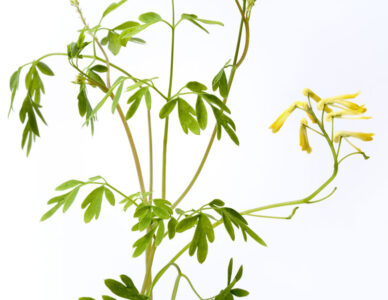Mexican mint marigold has a lot to offer. It thrives in the hot, humid South, where many herbs languish; its small, bright flowers blossom in fall when other herbs have played out for the season; its licorice-anise flavor is a successful stand-in for French tarragon; and it looks good in the garden.
This paragon, native to the mountains of Mexico and Guatemala, is a neat, upright bush some 3 feet tall with narrow, sharply toothed dark green leaves. Its scent recalls that of tarragon more than it does the pungent aroma of its familiar bedding-plant cousins, so-called French and African marigolds. In fall, if the growing season is long enough, the tips of the stems bear clusters of 3/8-inch golden yellow flowers.
Cloud plant, as this herb is known in Mexico, was first documented there in the sixteenth century by Spanish explorers. According to legend, the ancient Aztec chieftains used a powder made from the aromatic leaves of mint marigold to calm the hapless victims of sacrificial rituals. The leaves have also been used medicinally in folk remedies for malaria, colic, and colds; a poultice of the leaves is a traditional treatment for rattlesnake bite.
Besides cloud plant, Mexican mint marigold has many other aliases, most alluding to its fragrance: sweet mace, Mexican or winter tarragon, sweet- or mint-scented marigold, root beer plant, Mexican marigold mint, and yerba anis. Its Latin generic name, Tagetes, probably comes from Tages, an Etruscan deity said to be the grandson of Jupiter. A boy with the wisdom of an old man who sprang from the ground (or perhaps was plowed up), he taught the Etruscans the art of soothsaying. The specific name, lucida, means “bright” or “shining”, probably referring to the bright yellow-gold flowers.
T. lucida is closely related to both ordinary garden marigolds and the citrus-scented signet marigolds (T. tenuifolia). The latter are prized by herb gardeners as potpourri material as well as for their ornamental value. They are all native to the New World, unlike pot marigold (Calendula officinalis), the herb referred to as “marigold” by Gerard, Culpeper, and other great herbalists.
In the Kitchen
Chop the fresh leaves and use them to season chicken and tossed green salads, or brew them into a sweet, anise-flavored tea. The dried leaves retain their fragrance well if kept in a sealed glass container and protected from extreme heat and bright light.
Foil-baked fish is a fragrant treat when cooked with this herb. Place one pound of fresh fillets on a piece of buttered aluminum foil or parchment. Slash the fillets at 2-inch intervals and insert a thin slice of lemon into each cut. Dot the fish with butter, salt and pepper to taste, then sprinkle with a cup of chopped Mexican mint marigold leaves. Double-fold the edges of the foil to seal; fold parchment around the fish, letter style, then turn the ends under. Bake the packet no more than 20 minutes in an oven preheated to 350°F. The fish is done when it flakes easily. Avoid overcooking.
In the humid South, where French tarragon is difficult to grow, mint marigold is a fine culinary substitute. The flavor is almost indistinguishable from that of tarragon, but because mint marigold breaks down more quickly when heated, it’s best if added at the end of cooking. In salads, vinegars, oils, or quick-cooking recipes, substitute it for tarragon in equal proportions.
Crafts
Mint marigold’s dried leaves add fragrance to potpourris and sachets. Harvest the long stems just before frost when they are tipped with yellow-gold flowers. While they’re still green and pliable, weave them together in groups of six or nine as you would braid hair, then tie the two ends of each group together to form a circle. Dried leaves can be removed as needed for cooking. If the wreaths are made small and interwoven with other herbs, they can be tossed whole into a soup or stew as a bouquet garni.
The flowers add long-lasting color to dried arrangements and bouquets. They are attractive combined with sweet Annie, broom, and goldenrod in harvest centerpieces, or bundle the stems with natural-colored raffia for fragrant hang-ups that add a warm ambiance to any room. For a change of pace and scale, clip the stems short and make miniature bouquets in tiny vases. As with other marigolds, Mexican mint marigold looks good and lasts well in fresh flower arrangements as well.
Growing It
This handsome, robust plant thrives in almost any well-drained soil, including sand, and is relatively easy to grow. It has no special fertilization needs, and although it appreciates regular watering, it can withstand short droughts. For a full, well-formed plant with many blossoms, place it in full sun; in a shady garden, it will grow leggy and bear few flowers.
North of hardiness Zone 8, Mexican mint marigold is often raised as an annual. The slender black-and-white seeds are like those of garden marigolds but smaller–about 1/4 inch long. They germinate most readily at 70° to 75°F. The plants are grown much as garden marigolds are, but from seed, they take much longer to flower–six months compared to as little as six weeks for garden marigolds. Especially in the North, you may prefer to purchase young plants instead of raising them from seed. Seedlings or plants can go into the garden after the danger of frost is past. You can harvest the leaves throughout the growing season as soon as the plants have achieved some size. Mature leaves are not significantly tougher, more bitter, or less fragrant than the young, tender ones.
In warm regions, such as the Gulf Coast, Mexican mint marigold is evergreen. In cooler climates, you may be able to bring them through the winter outdoors under a heavy mulch. Where winters are really severe, you’ll need to pot them up before the first frost and bring them inside until warm weather returns. Your reward is a tarragon substitute that needs no winter dormancy period before it can produce harvestable leaves. I have never noticed any tendency toward particular diseases or pests, indoors or out.
Mexican mint marigold is easily propagated by division in early spring, just when it begins to send up new growth. (See “Divided They Stand”, page 30.) Keep the young divisions moist until they are established.
Another strategy is to take 6- to 8-inch semihard cuttings from established plants in fall or early spring. Strip off the lower leaves and stick the cuttings in sand in semishade. Keep the soil moist and warm and mist cuttings occasionally. In two weeks, gently pull on a cutting. If you feel resistance, it is rooted and can be transplanted to a pot or to a protected spot in the garden.
Mexican mint marigold is valued in the garden for its compact, predictable form and its versatility. Plant it along sidewalks and walkways as a fragrant low hedge. Mix it with other herbs and flowers in a sunny niche in a cottage garden or plant it in among rocks around a shallow pool, where its bright blooms will be reflected in the water. The flowers will attract bees and butterflies to the oasis.







